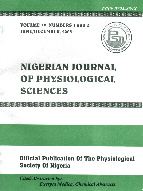
|
Nigerian Journal of Physiological Sciences
Physiological Society of Nigeria
ISSN: 0794-859X
Vol. 28, No. 2, 2013, pp. 211-219
|
 Bioline Code: np13027
Bioline Code: np13027
Full paper language: English
Document type: Research Article
Document available free of charge
|
|
|
Nigerian Journal of Physiological Sciences, Vol. 28, No. 2, 2013, pp. 211-219
| en |
Relationship between anthropometric and haematological parameters among third trimester pregnant women in Sokoto State, Northwest Nigeria
Bamaiyi, A.J.; Adelaiye, A.B. & Igbokwe, V.U.
Abstract
Summary: The pregnancy state in a woman's life is a unique state in terms of the desirable physiological changes and the exciting reversal of the changes soon after the termination of the pregnancy. It is considered essential that to guarantee a good feto-maternal outcome the attainment of optimum anthropometric and haematological parameters are key. Our study assessed the anthropometric and haematological changes and also looked at the relationship that exists between these parameters among pregnant women.We carried out a cross-sectional descriptive study which considered 160 apparently healthy, singleton, third trimester pregnant women attending ANC at the State Specialist Hospital and 58 apparently healthy non-pregnant controls sourced from the Sokoto metropolis population. Each subject or control enrolled was contacted 3 times at 2 weekly intervals. And at each occasion they are assessed for changes in the anthropometric and haematological parameters. The response rate was 93.6% (3 pregnants and 11 controls were loss to follow up). The pregnant and control subgroups mean ages were 28.02 ± 6.81 years and 26.89 ± 5.84 years respectively (p = 0.265). Weekly weight gains of 0.48kg among the pregnant sub-group against 0.13kg obtained in the control group were recorded. BMI increase of about 0.19kg/m2 per week among the pregnant sub-group and only 0.05kg per week in the controls. 95% of the distribution of pregnant sub-group has haemoglobin and haematocrit of ≥8.9g/dL and ≥26% respectively. Among the pregnant sub-group, mean weekly haemoglobin and haematocrit drop of 0.24g/dL and 0.74% were respectively recorded. A steady rise in WBC was recorded but platelets counts dropped at an average of 5.04 x 103 /μL per week. A positive correlation between BMI and haemoglobin levels was observed (r > 0 and p < 0.05). No particular regularity in the relationship between BMI and WBC was noticed. We conclude that there was optimum weight gain and good haematological indices for those with good BMI during the third trimester of pregnancy. There was a positive correlation between BMI and plasma haemoglobin level but WBC showed no particular relationship with the anthropometric changes. We therefore, recommend that good education to improve the socio- economic wellbeing of the girl-child be encouraged to boost self sufficiency for better weight gains and to facilitate access to good healthcare so that the ideal anthropometric and haematological parameters can be achieved during pregnancy to guarantee good feto-maternal outcome.
Keywords
Singleton; Trimester; Anthropometry; Haematological; Gestation; Parity
|
| |
© Nigerian Journal of Physiological Sciences
|
|
